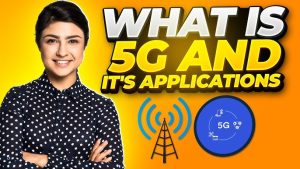Introduction
In 2025, 5G technology is changing the way we connect. It makes IoT (Internet of Things) connections faster, more reliable, and more efficient. By combining 5G and IoT Connectivity, new possibilities are opening up in fields like healthcare, transportation, and smart cities.
In this article, we’ll explore how 5G technology is improving IoT connectivity, iot security and what it means for the future. We’ll also look at the 5G IoT applications that are already making a difference and how they will keep growing in the coming years.
What Is 5G and How Does It Improve IoT Connectivity?

5G technology is the fifth generation of mobile networks. It is much faster than 4G, with speeds that can be up to 100 times quicker. It also has low latency, meaning there’s less delay when sending and receiving data. This is very important for IoT devices that need to work together in real-time.
Here’s how 5G improves IoT connectivity:
- Speed: 5G lets IoT devices send large amounts of data very quickly. This is important for things like smart cities or healthcare, where real-time data is needed.
- Low Latency: 5G reduces the time it takes for IoT devices to talk to each other. This makes things like self-driving cars or remote surgeries possible instantly.
- Capacity: 5G can support more devices. As more IoT devices join the network, 5G keeps them all connected without problems.
- Reliability: 5G gives a strong and stable connection, even when many devices are connected at the same time. This is crucial for places like smart factories or busy cities.
With these benefits, 5G is becoming the backbone of IoT connectivity, making it easier to connect more devices and manage them in real time.
Role of 5G in Expanding IoT Networks

5G plays a key role in making IoT networks bigger and better. By offering faster speeds, more bandwidth, and a stronger connection, 5G allows more devices to connect. This means more devices can be used in homes, cities, and factories without slowing down the network.
For industries like manufacturing, 5G helps connect IoT devices for things like automation, predicting problems, and managing supplies. For consumers, 5G makes smart devices work better, from voice assistants to smart thermostats.
Overall, 5G helps IoT systems grow, making them more reliable, easy to scale, and part of everyday life.
How 5G is Impacting IoT Applications in 2025

By 2025, 5G technology will play a big role in many important IoT (Internet of Things) applications. This will change industries like healthcare and smart cities. Let’s explore some ways 5G is improving IoT connectivity.
1. Smart Cities
5G technology is important for building smart cities. In these cities, IoT devices manage things like traffic lights and waste management. With 5G, cities can use real-time data to improve services and save money.
For example, 5G will help control traffic by changing the timing of traffic lights based on how many cars are on the road. This reduces traffic jams and pollution, making cities smarter and more efficient. 5G also helps save energy by allowing smart grids to send power where it’s needed the most.
2. Healthcare and Remote Monitoring
In healthcare, 5G IoT applications are making a big difference. IoT devices can monitor a patient’s health and send data to doctors instantly. This means doctors can give help without being in the same room.
For example, doctors can perform remote surgeries using 5G-powered robots. This lets them help patients from anywhere. 5G’s low latency makes sure the surgeries are quick and safe.
3. Autonomous Vehicles
5G is essential for autonomous vehicles (self-driving cars). These cars need to talk to each other, traffic lights, and other systems. 5G makes this communication happen quickly.
With 5G’s high speed and low delay, self-driving cars can make fast decisions. For example, cars can react to sudden changes in traffic or road conditions in real time, making driving safer.
4. Smart Manufacturing
In factories, 5G helps machines talk to each other through IoT devices. This makes production lines run more smoothly and efficiently. 5G ensures machines can send and receive data instantly, cutting down on downtime and boosting production.
For instance, sensors on machines can find problems before they happen. This helps prevent breakdowns, saving time and money.
5. Agriculture and Smart Farming
In farming, 5G IoT connectivity helps farmers monitor crops and animals. IoT devices can check things like soil moisture, temperature, and crop health in real time. With 5G, farmers can get this data right away, letting them act quickly.
For example, drones with IoT sensors can fly over fields, gather data, and spread fertilizers or pesticides where needed. This makes farming more efficient and helps grow more crops.
Challenges in Implementing 5G for IoT
Even though 5G has a lot of potential, there are challenges to using it for IoT. One big problem is the cost of building the infrastructure. Setting up 5G networks requires a lot of money to build new towers, antennas, and equipment for fast communication.
Another challenge is that 5G coverage may not reach rural or less developed areas, which makes it harder to get the benefits of 5G everywhere. There are also concerns about data security. Since more devices are connected, they create lots of sensitive information, which needs to be protected from cyber threats.
Lastly, not all IoT devices are made to work with 5G. This means some devices may need to be upgraded or replaced, which can be expensive and take a lot of time.
The Future of 5G and IoT Connectivity

As 5G IoT technologies keep getting better, IoT connectivity will become even stronger and improve efficiency. In the next few years, we can expect to see:
1. More Devices Connected Globally
With 5G, billions of IoT devices will connect all around the world. This will create huge network connections where devices work together smoothly. From homes to cities to factories, 5G IoT connectivity will make everything more efficient.
2. Increased Automation
5G networks will help more industries automate their operations. In factories, for example, 5G will allow machines to work together in real-time, increasing production and reducing mistakes. In healthcare, 5G robots could perform surgeries without human help.
3. Smarter Consumer Devices
At home, 5G IoT devices will make life easier. Smart homes will be able to talk to more devices faster, making everything from lighting to security smarter. For example, your thermostat, lights, and door locks will work together, changing settings based on what you need.
4. Global IoT Networks
In the future, 5G will create global networks where IoT devices work together across different regions and industries. This will help create smarter solutions for things like delivery systems and environmental monitoring.
Comparative Table: How 5G Improves IoT Connectivity in Different Industries
| IoT Application | 5G Impact | Key Benefits |
|---|---|---|
| Smart Cities | Real-time communication between devices | Efficient traffic management, energy savings |
| Healthcare | Remote patient monitoring, real-time data | Faster diagnostics, remote surgeries |
| Autonomous Vehicles | Instant data exchange between vehicles | Improved safety, faster decision-making |
| Smart Manufacturing | Real-time monitoring and automation | Increased efficiency, reduced downtime |
| Agriculture | IoT sensors, drones, autonomous equipment | Increased crop yield, sustainable farming |
Conclusion
5G advancements are transforming the world of IoT connectivity in 2025. From smart cities to autonomous vehicles, 5G technology is enabling faster, more reliable communication between IoT devices. This opens up new possibilities for industries to operate more efficiently, safely, and sustainably.
As 5G continues to evolve, we will see even more connected devices and smarter applications across every sector. The future of IoT and 5G connectivity is bright, and the impact will be felt in everyday life.
Call to Action
Ready to learn more about how 5G advancements are shaping IoT connectivity? Explore the latest 5G technologies and IoT applications by visiting [your preferred tech platform] today!










